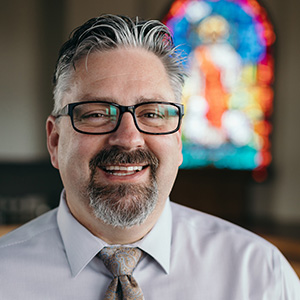The Paschal Homily of Saint John Chrysostom
Reflections from President Thomas
The Eastern Orthodox communities around the world celebrate Holy Week with the same festivals as the Western Church, including Palm Sunday, Maundy Thursday, Good Friday, Holy Saturday, and Resurrection Sunday. However, a few of their practices are distinct. For Orthodox Christians, the breaking of the Lenten fast occurs during the late hours of Holy Saturday and the opening hours of Resurrection Sunday. The Orthodox gather before midnight into a largely darkened and silent sanctuary which symbolizes the darkness and loneliness of the tomb and of death, for Christ is still entombed.
Meanwhile the priests are busily preparing for the Eucharistic meal behind the iconostasis, the wall that separates the nave from the altar which is covered with painted icons. Usually only a small candle is illuminated behind the iconostasis. As the service begins, the three doors of the iconostasis are closed. Then the priest lights another candle then another. The congregation only sees the faintest of light shining through the spaces around the doors. Then the great door opens, and light floods out into the nave. The priests process through the doors and light the candles of the congregants who in turn light the candles of others until the nave is filled with the Light of Christ, the great symbol that death has been swallowed up by death.
At this time, they start singing a very ancient hymn in a repetitive fashion. They actually sing this dozens of times throughout the three hour service. It is called the Paschal Troparion (also known in Greek as the Christos anesti: Christ is Risen).
The translation of what they are singing is the following:
Christ is risen from the dead,
Trampling down Death by death,
and upon those in the tombs,
Bestowing Life.
(Listen in English, Arabic, and Greek.)
This brings us to the homily by John Chrysostom who served as the Bishop of Constantinople (died September 14, 407). The Troparion is inspired obviously by this sermon. What is remarkable is that for more than a millenium the Orthodox communities throughout the world have used this very sermon during this paschal service. The priest literally reads this homily to the congregation. John starts by acknowledging that the fast of Lent is ending in this Feast of Resurrection. And I love his acknowledgement that many have failed in their Lenten devotions! And he uses arresting language about death being swallowed by death. And that Christ's resurrection opens the tombs of the dead...including our own tomb when that day comes.
At the end of the Orthodox service, they indeed break the fast. They eat a red-dyed egg which symbolizes the blood of Christ. Cracking the egg represents Life coming out from the tomb. Thereafter, they eat a huge feast.
Despite the beauty of this divine service (and it is wonderfully beautiful), they do not practice the tradition of the Sunrise service which is how so many Western Christians celebrate the Sunday of the Resurrection of the Christ. If one only attends the Orthodox service at the depths of the night, there is something missing, at least for me. The early morning service is the commemoration of the visit to the empty tomb during the morning and being greeted by the antiphonal proclamation by the pastor that "He is Risen." to which the congregation acclaims "He is Risen indeed. Alleluia."
I have attended both services on the same Easter Sunday several times. It's quite an experience. If you ever get the chance, I highly encourage it.
What makes Christianity so amazing is the richness of the traditions that grow from the early Christian communities in Jerusalem and beyond that are eventually rooted in new cultural soils that give the Biblical traditions amazing depth.
.
May God richly bless your Holy Week!

Michael A. Thomas, Ph.D.
President, Concordia University Irvine